
A plough or plow is a farm tool for loosening or turning the soil before sowing seed or planting. Ploughs were traditionally drawn by oxen and horses but in modern farms are drawn by tractors. A plough may have a wooden, iron or steel frame with a blade attached to cut and loosen the soil. It has been fundamental to farming for most of history. The earliest ploughs had no wheels; such a plough was known to the Romans as an aratrum. Celtic peoples first came to use wheeled ploughs in the Roman era.

A tire or tyre is a ring-shaped component that surrounds a wheel's rim to transfer a vehicle's load from the axle through the wheel to the ground and to provide traction on the surface over which the wheel travels. Most tires, such as those for automobiles and bicycles, are pneumatically inflated structures, providing a flexible cushion that absorbs shock as the tire rolls over rough features on the surface. Tires provide a footprint, called a contact patch, designed to match the vehicle's weight and the bearing on the surface that it rolls over by exerting a pressure that will avoid deforming the surface.

Continuous track or tracked treads are a system of vehicle propulsion used in tracked vehicles, running on a continuous band of treads or track plates driven by two or more wheels. The large surface area of the tracks distributes the weight of the vehicle better than steel or rubber tyres on an equivalent vehicle, enabling continuous tracked vehicles to traverse soft ground with less likelihood of becoming stuck due to sinking.
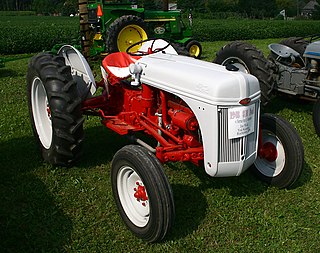
A tractor is an engineering vehicle specifically designed to deliver a high tractive effort at slow speeds, for the purposes of hauling a trailer or machinery such as that used in agriculture, mining or construction. Most commonly, the term is used to describe a farm vehicle that provides the power and traction to mechanize agricultural tasks, especially tillage, and now many more. Agricultural implements may be towed behind or mounted on the tractor, and the tractor may also provide a source of power if the implement is mechanised.

A skid loader, skid-steer loader, SSL, or skidsteer is any of a class of compact heavy equipment with lift arms that can attach to a wide variety of buckets and other labor-saving tools or attachments.

A loader is a heavy equipment machine used in construction to move or load materials such as soil, rock, sand, demolition debris, etc. into or onto another type of machinery.

A backhoe—also called rear actor or back actor—is a type of excavating equipment, or excavator, consisting of a digging bucket on the end of a two-part articulated arm. It is typically mounted on the back of a tractor or front loader, the latter forming a "backhoe loader". The section of the arm closest to the vehicle is known as the boom, while the section that carries the bucket is known as the dipper, both terms derived from steam shovels. The boom, which is the long piece of the backhoe arm attached to the tractor through a pivot called the king-post, is located closest to the cab. It allows the arm to pivot left and right, typically through a range of 180 to 200 degrees, and also enables lifting and lowering movements.
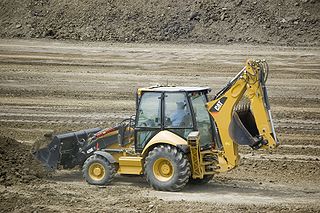
A backhoe loader, also called a loader backhoe, loader excavator, tractor excavator, digger or colloquially shortened to backhoe within the industry, is a heavy equipment vehicle that consists of a tractor-like unit fitted with a loader-style shovel/bucket on the front and a backhoe on the back. Due to its (relatively) small size and versatility, backhoe loaders are very common in urban engineering and small construction projects as well as developing countries. This type of machine is similar to and derived from what is now known as a TLB (Tractor-Loader-Backhoe), which is to say, an agricultural tractor fitted with a front loader and rear backhoe attachment.

Heavy equipment, heavy machinery, earthmovers, construction vehicles, or construction equipment, refers to heavy-duty vehicles specially designed to execute construction tasks, most frequently involving earthwork operations or other large construction tasks. Heavy equipment usually comprises five equipment systems: the implement, traction, structure, power train, and control/information.
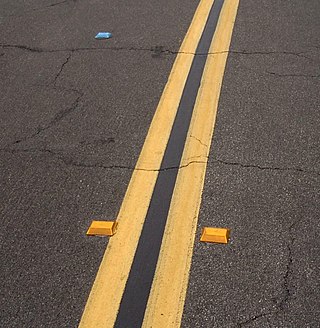
A raised pavement marker is a safety device used on roads. These devices are usually made with plastic, ceramic, thermoplastic paint, glass or occasionally metal, and come in a variety of shapes and colors. Raised reflective markers, such as plastic, ceramic, or metal ones, include a lens or sheeting that enhances their visibility by retroreflecting automotive headlights, while glass road studs gather automotive headlights with a dome shape and reflect the lights with a reflective layer within. Some other names for specific types of raised pavement markers include convex vibration lines, Botts' dots, delineators, cat's eyes, road studs, or road turtles. Sometimes they are simply referred to as "reflectors".
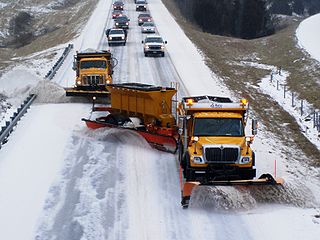
A snowplow is a device intended for mounting on a vehicle, used for removing snow and ice from outdoor surfaces, typically those serving transportation purposes. Although this term is often used to refer to vehicles mounting such devices, more accurately they are known as winter service vehicles, especially in areas that regularly receive large amounts of snow every year, or in specific environments such as airfields. In other cases, pickup trucks and front end loaders are outfitted with attachments to fulfill this purpose. Some regions that do not frequently see snow may use graders to remove compacted snow and ice off the streets. Snowplows can also be mounted on rail cars or locomotives to clear railway tracks.

Snow removal or snow clearing is the job of removing snow after a snowfall to make travel easier and safer. This is done both by individual households and by governments, institutions, and commercial businesses.

Snow chains, or tire chains, are devices fitted to the tires of vehicles to provide increased traction when driving through snow and ice.

The Schleicher K 8 is a single-seat glider designed by Rudolf Kaiser and built by the Alexander Schleicher company in Germany.

A winter service vehicle (WSV), or snow removal vehicle, is a vehicle specially designed or adapted to clear thoroughfares of ice and snow. Winter service vehicles are usually based on a dump truck chassis, with adaptations allowing them to carry specially designed snow removal equipment. Many authorities also use smaller vehicles on sidewalks, footpaths, and cycleways. Road maintenance agencies and contractors in temperate or polar areas often own several winter service vehicles, using them to keep the roads clear of snow and ice and safe for driving during winter. Airports use winter service vehicles to keep both aircraft surfaces, and runways and taxiways free of snow and ice, which, besides endangering aircraft takeoff and landing, can interfere with the aerodynamics of the craft.

A heavy equipment operator operates heavy equipment used in engineering and construction projects. Typically only skilled workers may operate heavy equipment, and there is specialized training for learning to use heavy equipment.
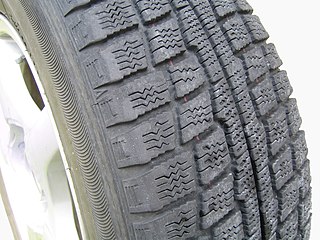
Snow tires, also known as winter tires, are tires designed for use on snow and ice. Snow tires have a tread design with larger gaps than those on conventional tires, increasing traction on snow and ice. Such tires that have passed specific winter traction performance tests are entitled to display a 3PMSF and/or a IMP symbols on their sidewalls. Tires designed for winter conditions are optimized to drive at temperatures below 7 °C (45 °F). Studded tires are a type of snow tires which have metal or ceramic studs that protrude from the tire to increase traction on hard-packed snow or ice. Studs abrade dry pavement, causing dust and creating wear in the wheel path. Regulations that require the use of snow tires or permit the use of studs vary by country in Asia and Europe, and by state or province in North America.
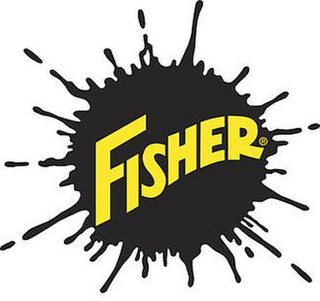
Fisher Engineering is an American manufacturer of snowplows and other professional snow removal equipment, located in Rockland, Maine. Fisher Engineering is a subsidiary of Douglas Dynamics, which also owns Western Products, Blizzard, and TrynEx International, each producing their own snowplow brands.

The wedge plow or Bucker plow was first developed by railroad companies to clear snow in the American West. The wedge plow forces snow to the sides of the tracks and therefore requires a large amount of force due to the compression of snow. The wedge plow is still in use today in combination with the high-maintenance rotary snowplow.

The Mack Granite is a series of heavy duty and severe service trucks built by Mack Trucks. It has a long, low-profile hood and a high-visibility cab. Designed as straight trucks for local construction, waste removal, and other vocational jobs, it is also available as a semi-tractor. Introduced in 2001, it remains in production as of today.























